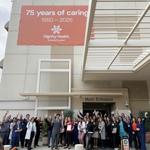Despite its structural deficit, Foster City decided not to pursue a couple potential tax measures, but it still leaves a question mark as to how it plans to bridge its fiscal gap.
Many cities throughout the county are grappling with long-term budget shortfalls, with several councils contemplating various tax measures to go on the 2026 election. During a recent City Council meeting, South San Francisco elected leaders leaned toward a parcel tax measure, which could help close its $12 million general fund deficit. In San Mateo, the council expressed interest in exploring a sales tax measure and general obligation bond to close its current and ongoing deficit.
Foster City estimates a $3.8 million shortfall expected for the 2025-26 year and a continued structural deficit over at least the next five years, though councilmembers were still hesitant to move forward on a couple options, one of which was a commercial vacancy tax.
“I'm not in support of this vacancy tax,” Councilmember Phoebe Venkat said. “I just don't know if it would benefit us the way we want it to.”
The other option was a transfer tax, a one-time tax during the sale of property – though that would require a costly, time-consuming process of becoming a charter city, which operates slightly differently than a general law city.
“We’ve been addicted to taxing,” Vice Mayor Art Kiesel said. “Are we getting to the point where our taxes are going to run the well dry? And then what?”
But even though the council expressed skepticism on further tax increases, Mayor Stacy Jimenez said there is not a clear solution on how the city plans to fill the gap. Discussion centers around economic development, such as revitalizing long-vacant buildings or incentivizing new businesses to come to Foster City, though details of such a plan have yet to be determined.
The city has been able to bring in large firms like Gilead, Visa and Zoox. But with its unique geography away from a major public transit corridor, it presents unique challenges, Jimenez added.
“We’re in a different position than other cities in that we’re not a transit line, and we often find it difficult to get some of the grant money that other cities can get,” Jimenez said. “We’re not necessarily an easy jump off [Highway] 101 where people can just hop in, grab dinner and hop out, so economic development looks different than any other city in the county.”

























(1) comment
This is good news for Foster City residents, at least for now. How much money would Foster City have saved if they didn’t continue wasting money to address their Canadian geese issue? How much have consultants received? Perhaps those costs are part of the $3.8 million shortfall. And did Foster City really need a new recreation center? How much is that cost adding to the shortfall this fiscal year and into the future? Maybe a volunteer DOGE team to help Foster City with fiscal management?
Welcome to the discussion.
Log In
Keep the discussion civilized. Absolutely NO personal attacks or insults directed toward writers, nor others who make comments.
Keep it clean. Please avoid obscene, vulgar, lewd, racist or sexually-oriented language.
Don't threaten. Threats of harming another person will not be tolerated.
Be truthful. Don't knowingly lie about anyone or anything.
Be proactive. Use the 'Report' link on each comment to let us know of abusive posts.
PLEASE TURN OFF YOUR CAPS LOCK.
Anyone violating these rules will be issued a warning. After the warning, comment privileges can be revoked.